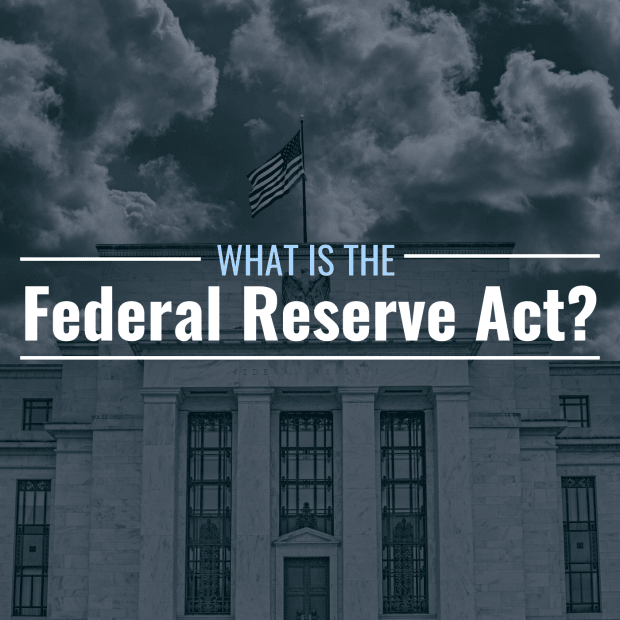
Douglas Rissing from Getty Images Signature; Canva
What Is the Federal Reserve Act of 1913?
Passed by Congress and signed into law by President Woodrow Wilson, the Federal Reserve Act of 1913 created the Federal Reserve, which is the central banking system of the United States. The Federal Reserve, known colloquially as the Fed, exerts a powerful influence over every aspect of the U.S. economy. Through this Act, lawmakers sought to eliminate the bank runs and panics that had up until then been plaguing the banking system. In the Federal Reserve Act’s subsequent amendments, the Fed would adopt the “dual mandate” it’s now known for: fostering stable prices and strong employment for the American people.
Why Was the Federal Reserve Act Passed?
The early days of the U.S. banking system might best be described as chaotic. Before the Civil War, most of the country’s banks were chartered by individual states. During Reconstruction, banks became privatized, which meant they had commercial operations but were chartered by the federal government; however, they were all restricted to a single location. Banking branches did not exist back then, which made the banking system incredibly unstable. Imagine the difficulty a bank would have in growing operations or even diversifying its loan portfolio when it operated in such a limited fashion.
During this period, the U.S. currency was considered to be “inelastic” because a bank could only issue as many currency notes as the number of government bonds it held. This made the bank unresponsive to any changes in demand and thus incredibly susceptible when its customers decided to withdraw their deposits simultaneously.
On Wall Street, the country’s lack of monetary policy had fostered rampant speculation, and crises unfolded at a regular cadence. For example, the Knickerbocker Crisis of 1907 stemmed from uncollateralized loans and sparked a contagion that would infect the entire financial system—until a private financier, J.P. Morgan, personally ended it.
During this three-week banking crisis, the New York Stock Exchange lost 50% of its value, and it would go down in history as the second-worst stock market crash after the Great Depression. But the event was also transformative in that it finally convinced lawmakers of the need for greater regulation over the country’s financial institutions as well as the formation of a centralized banking authority.
What Did the Federal Reserve Act Create?
Simply put, the Federal Reserve Act began monetary policy as we know it.
In an effort to make sure that every bank would be equipped with the resources its customers needed, the Federal Reserve Act effectively created a structure for the flow of money and credit throughout the United States. It contained several key outcomes:
Federal Reserve Notes
The Federal Reserve Act gave the Fed the ability to print money. It created a new form of currency, the Federal Reserve note, which is more commonly known as the dollar. In addition, the foundation of Federal Reserve Banks enabled this currency to move into circulation quickly.
Federal Reserve Banks
Under the Federal Reserve Act, twelve regional Federal Reserve Banks oversee the day-to-day activities of the financial institutions within their jurisdictions, serving as a critical link between the Fed’s Washington, DC, headquarters and the American people. Some of the Federal Reserve Banks’ responsibilities include printing currency, making loans, and reporting economic data to the Federal Reserve Board of Governors so it can regulate prevailing interest rates via adjustments to the Fed funds rate at its Federal Open Market Committee Meetings (FOMC).
The 12 regional Federal Reserve Banks are located in the following cities:
- Boston
- New York City
- Philadelphia
- Cleveland
- Richmond
- Atlanta
- Chicago
- St. Louis
- Minneapolis
- Kansas City
- Dallas
- San Francisco
Federal Reserve Board of Governors
The Federal Reserve Act also created the Federal Reserve Board of Governors, who oversee the 12 Federal Reserve Banks, set their reserve requirements, and manage the discount window. They also draft policy through the economic data they collect from regular surveys of their member banks.
There are seven members on the Board of Governors, including the Fed Chair and the Fed Vice Chair, and the Federal Reserve Act mandates that these individuals represent a diversity of American interests in the financial, agricultural, industrial, and commercial sectors.
Currently serving on the Federal Reserve Board of Governors are:
- Jerome H. Powell, Chair
- Michael S. Barr, Vice Chair for Supervision
- Michelle W. Bowman
- Lisa D. Cook
- Philip N. Jefferson
- Christopher J. Waller
Discount Window
All nationally chartered banks are required to become members of the Federal Reserve system. That means that they own stock in and hold reserves with their regional Federal Reserve Bank. In exchange for their membership, the Federal Reserve offers special protections to its member banks so that they don’t experience default. The formation of the discount window, for example, offers a “no questions asked” conduit for emergency liquidity when a financial institution is in distress. These institutions also receive a 6% dividend on the stock they purchase with their Federal Reserve Bank.
Who Opposed the Federal Reserve Act?
It would take three years for Congress to support the need for a central banking authority. Earlier proposals were criticized for giving too much power to banks: The Aldrich-Vreeland Act, adopted shortly after the Knickerbocker Crisis in 1908, created a National Monetary Commission, which was the predecessor to the Federal Reserve.
In 1910, a powerful cohort of investment bankers and Treasury officials secretly met on Jekyll Island, Georgia, to refine this plan. Fearing retribution, they used the excuse that they were going duck hunting and went only by their first names.
Their resulting bill, known as the Aldrich Plan, was unveiled in 1912 and proposed a 46-member governing board, with only 6 of those governors being government officials. This plan was attacked by both political parties for not giving the government adequate control.
Another plan, introduced by then-Congressman William Jennings Bryan, consisted of greater government oversight.
But it was ultimately a bill by Congressman Carter Glass that reached a compromise between the interests of the banks and the interests of the government. The Glass Bill proposed a system of as many as 20 regional banks instead of one, central board. President Wilson added the concept of the Federal Reserve Board as the supervisory authority to the Reserve Banks; these officials would be appointed by both the President as well as members of the Reserve Banks.
Senator Robert L. Owen then refined the number of regional banks to 12 and made additional tweaks to the board’s regulatory structure; this was the bill that would ultimately become the Federal Reserve Act.
Who Signed the Federal Reserve Act?
After the election of 1912, Democrats controlled both sides of Congress. The Act passed the House of Representatives in September 1913. It was adopted by the Senate in a vote of 43 to 25 on December 23, 1913, with lawmakers rushing out to begin their holiday vacations soon after passing it. Later that day, President Woodrow Wilson signed the Federal Reserve Act into law.
The Federal Reserve Act is considered one of the most significant accomplishments of the Wilson Administration.
What Were Some Amendments to the Federal Reserve Act?
The Federal Reserve Act has witnessed more than 200 changes through the years—its notable amendments include:
- In 1917, an amendment relaxing the gold standard was introduced in order to fund America’s World War I efforts—a staggering $2 billion. Currency in circulation doubled over the next six months, as did inflation.
- The Banking Act of 1933 created the Federal Open Market Committee and began the government’s open market operations—the buying and selling of Treasury securities.
- In 1977, the Federal Reserve Act was amended to promote what would become known as its dual mandate: “To promote effectively the goals of maximum employment, stable prices, and moderate long-term interest rates.”
Can the Federal Reserve Act Be Reversed?
According to the Fed, the original Federal Reserve Act contained a 20-year charter; however, the McFadden Act of 1927 rechartered this act “into perpetuity,” and so the Federal Reserve has no expiration date.







